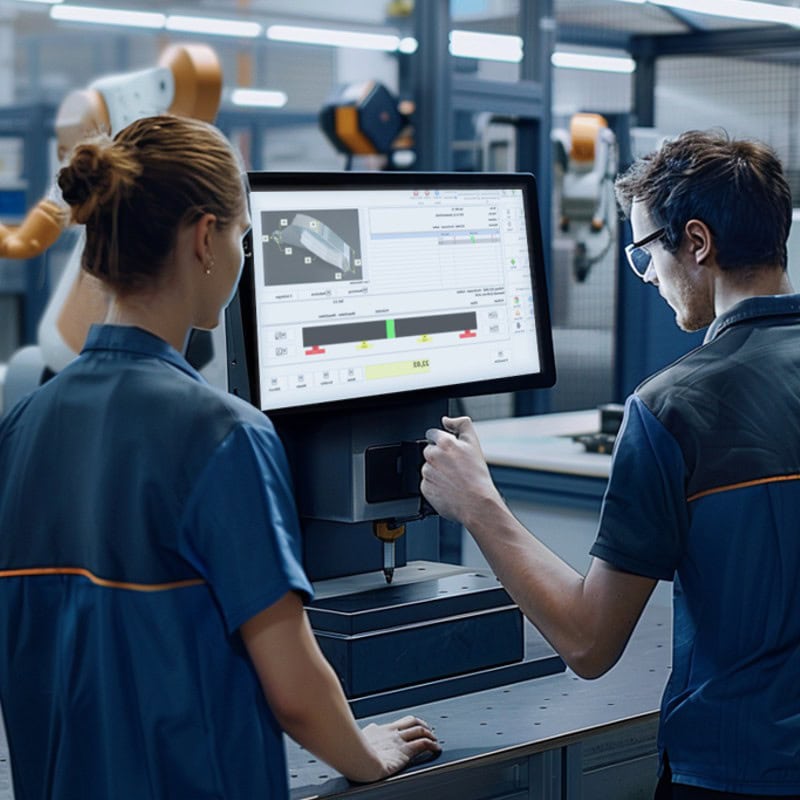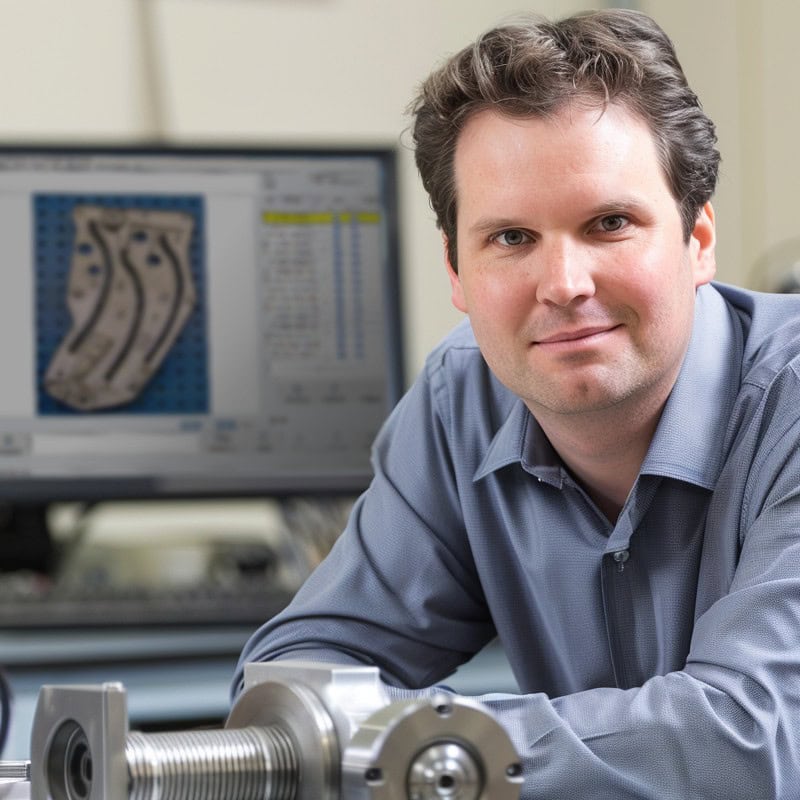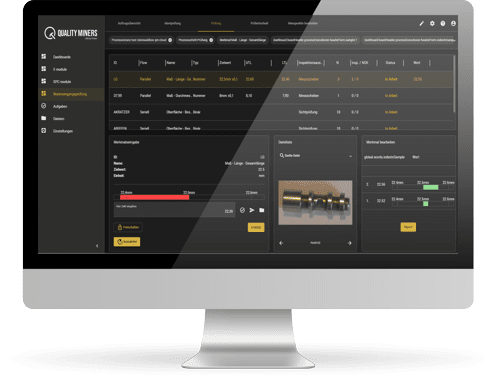Quality Mining, the interaction of quality, production, and process
360° coverage on the shop floor for your quality assurance
With Quality Mining, we seamlessly combine quality, production, and processes into a holistic unit. Our 360° shop floor coverage integrates IT and OT systems (information technology and operational technology) and enables our customers to achieve the highest quality standards.
The path to sustainable success
Products and services
Our customized products and services—including the CAQ solution QM.CAQ, the SAP® extension for QM functions with SQM360, the CAQ industry solution CAQ360 for the metalworking industry, and the intelligent machine data acquisition system MDE360 – combine comprehensive concepts, tried-and-tested procedures, and software products with decades of expertise, in-depth experience, and a hands-on mentality that prioritizes pragmatic and solution-oriented approaches.
Working together step by step towards customer success
For us, customer success is paramount—through maximum transparency, agile and step-by-step implementation, and the ability to intervene flexibly at any time, we create investment security and promote long-term partnerships based on close cooperation and mutual success.
Why Quality Miners?
Because we have decades of experience combining manufacturing with IT and OT technology. With the right mix of standardized components for short project durations and individual customization for maximum goal achievement, we create sustainable success—always with a focus on people and their needs. This combination of innovation, pragmatism, and humanity is the key to sustainable customer success.
The five core elements of quality mining


Questioning specifications and making them usable
Standards and guidelines are often rigid. Thanks to our experience, targeted analyses, and digital tools, we implement them in a practical manner—without disrupting the production flow.

Simplify processes
We often encounter overly complicated workflows for processes that cause waste and errors. Digital quality gates, targeted automation, and seamless interfaces make processes leaner and more efficient.

Reduce complexity
The controllability and comprehensibility of processes are increased through standardized interfaces, the integration of operating technology, proven analysis methods (e.g., supplier evaluations, Pareto analyses, SPC methods), and the targeted visualization of relevant data on the shop floor.

Optimize cycle times
Real-time data, focused inspection and work plans, and the linking of quality and machine data optimize cycle times—without compromising quality. Standardized processes and targeted worker guidance reduce setup times, while traceable processes make delays transparent.

Targeted use of automation
Automation is used in a targeted manner to create real added value. Routine tasks are automated using hardware and software, while human expertise remains where it is indispensable. Machines, sensors, software, and measuring systems provide usable data and help to simplify processes.
Examples of Quality Mining

Questioning specifications and making them usable
- The testing strategy does not distinguish between critical and non-critical characteristics, which leads to high testing costs.
- Despite passing the incoming goods inspection, fitting problems occur during final assembly because the actual process risks are not taken into account.
Quality Mining solution:
CTQ-based testing strategy instead of blanket dimensional testing
- Quality-critical characteristics (CTQs) and critical characteristics with a direct influence on function and service life are subjected to intensive testing.
- Non-critical dimensions → Only random sampling or proof of process capability by the supplier.
Dynamic adjustment via structured root cause analysis
- If production problems arise, a systematic cause assessment (IS-IS-NOT, 5-Why) is carried out via the integration of complaint and action management into the worker guidance system.
- Failure patterns are consistently fed back into the incoming goods inspection via changes in the control plan and FMEA.
Result:
- 30% less testing effort, as only CTQ characteristics are tested intensively.
- Improved process reliability, as incoming goods inspections are tailored to real risks.
- No uncontrolled changes to test plans, but systematic adjustments.

Problem:
Installation errors occur because seals are inserted incorrectly. Training only helps in the short term, and rework incurs high costs.
Quality Mining solution:
Digital worker guidance with poka-yoke
- The assembly process is supported by a digital worker assistance system (vision-based, RFID) that is seamlessly connected to the CAQ.
- During the assembly process, poka-yoke safety devices prevent components from being inserted incorrectly.
- The CAQ system documents each assembly step via an interface and prevents subsequent process steps from being omitted.
- Serial number tracking using barcodes
Result:
- 80% reduction in assembly errors, as workers are immediately alerted to problems.
- No waste due to incorrect parts, as Poka-Yoke provides security.
- Digital documentation with serial number tracking

Reducing complexity – Automatic test control & digital worker guidance
Problem:
In the manufacture of structural components, workers must document measurements manually, which is time-consuming and prone to errors. In addition, inspection intervals are defined as rigid specifications, leading to unnecessary inspection efforts or unrecognized process instability.
Quality Mining solution:
Digital worker guidance with test equipment integration
- Test assignments appear mobile & context-related with clear instructions.
- Measurements are automatically recorded and documented via MQTT, without manual input.
Adaptive testing strategies for less effort and greater security
- Inspection severity adapts: Stable processes → inspection rate decreases, deviations → inspection rate increases.
- Real-time verification with the CAQ system to detect errors at an early stage.
Result:
- 30% less testing effort, as testing is only intensified when necessary.
- 100% digital documentation, no paper records or manual errors.
- Faster responses to deviations, as actions and complaints are automatically triggered from the inspection dialog.
 Optimize cycle times –
Optimize cycle times –Real-time quality control & machine connectivity
Problem:
In the production of medical devices, dimensional deviations occur time and again.
Spot checks often detect errors too late or not at all.
The lack of real-time feedback between machine and quality data means that sources of error cannot be eliminated at an early stage.
In the event of an error, the machine is readjusted and the collection boxes produced are subjected to a re-inspection.
Quality Mining solution:
100% inline inspection with direct machine connection
- Optical sensors detect each unit produced inline and check dimensional accuracy, including documentation of a time stamp.
- If a deviation is detected, the faulty part is immediately rejected.
- The CAQ system stores all test data and sends feedback to the machine control system.
Machine and quality data in a control loop
- Analysis of the data reveals whether dimensional deviations are caused by tool wear, material changes, or process parameters.
- If a pattern is recognized, process adjustments are made (e.g., release checks during machine adjustment or interval-dependent tool changes).
Result:
- Zero-defect strategy, as rejects are detected and eliminated at an early stage.
- Reduction of testing times by 50%, as manual intervention is no longer necessary.
- Higher machine availability and more stable processes through direct quality feedback.

Problem:
A machining company changes tools either too early or too late.
- Too early: Tool costs rise unnecessarily, frequent interruptions occur.
- Too late: quality problems and rejects increase.
Quality Mining solution:
Tool change control via machine data & CAQ
- The CAQ system automatically evaluates machine counters and quality data.
- Once a critical number of components has been processed, a scheduled tool change is triggered.
- If SPC data shows that dimensional stability is changing, the change can be made earlier.
Result:
- Extension of tool life by 20% without compromising quality.
- Automated process without manual planning or monitoring.
- Automated shift logs and evaluations are available
Let’s talk!
Discover how Quality Mining can advance your business.






